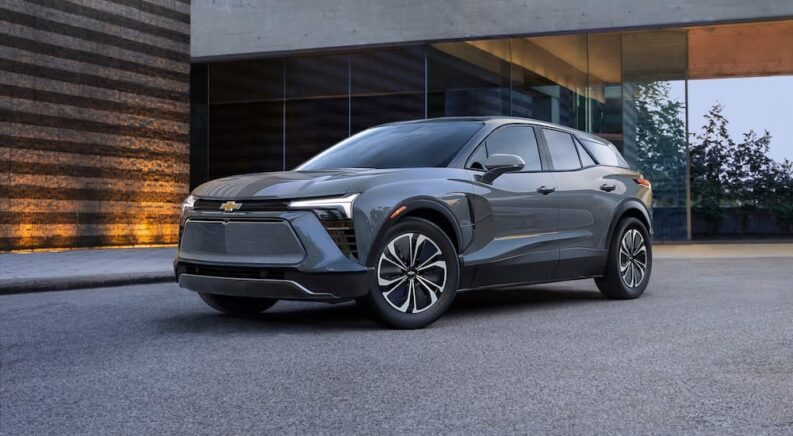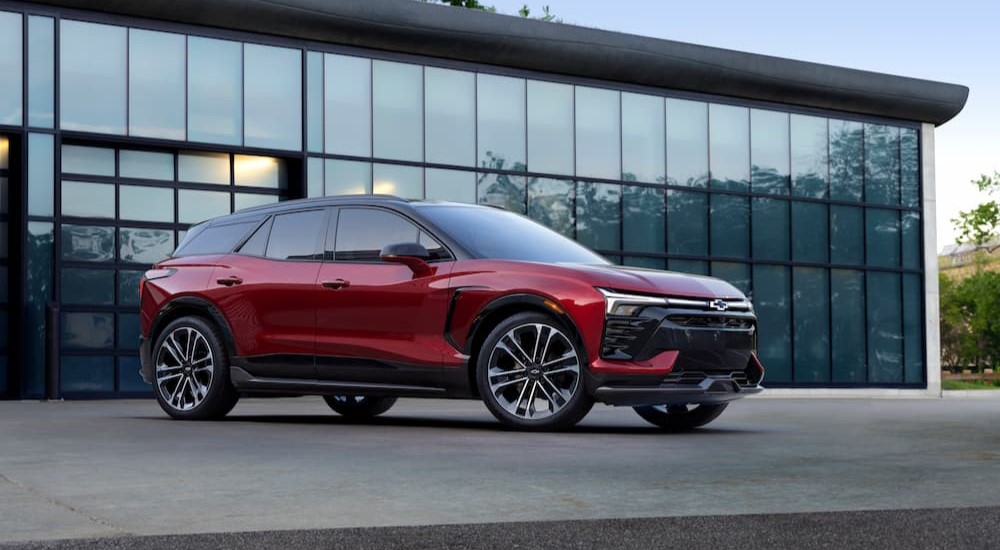For the 2024 model year, we’ll begin to see the much-anticipated Blazer EV for sale in dealerships across the country. At the top of its trims, you’ll find a sporty SS that’s designed to deliver thrilling driving dynamics.
Even five years ago, the idea of an SUV that’s both all-electric and performance-oriented while still striving to be affordable to everyday drivers would have seemed like a strange novelty—but today, the Blazer EV SS is joining a niche that is already well-populated with household names. Ford has its Mustang Mach-E GT, Kia has the GT trim of its EV6, and Tesla’s Model Y has a simply named “Performance” trim.
The Frankenstein-like nature of an affordable performance EV SUV gives these models a tall order to fill. SUVs become more useful if they have more interior cargo space, but sleek and lightweight vehicles can deliver better performance. For EV technology to be practical for everyday driving, the battery needs to provide a solid range, but bigger, better batteries are more expensive to make.
So, how do the models in this space balance all of these factors? Let’s take the temperature of this niche-but-growing segment of the auto market and see where things stand today.
Performance
Let’s start right off with the exciting part: performance.
While EVs started out prioritizing efficiency above all else, automakers have been playing around with electric motors in recent years and using their natural strengths to improve performance. For instance, electric motors are naturally better than internal-combustion engines at providing a lot of torque at low speeds. That can come in handy when you want an impressive zero-to-sixty figure, giving you bragging rights and something tangible to make your model look good, compared both to other EVs and to more traditional performance vehicles.
All four of the models we’re looking at can go from zero to sixty in under four seconds. As of now, that’s as much as we know about the Blazer EV since Chevy hasn’t released a more specific figure, and the SS trim won’t be available for drivers to test for themselves until the spring of this year. But Chevrolet does have specs for the electric powertrain, and its 557 hp beats nearly all of the other competitors while its 648 lb-ft of torque puts it squarely on the top of the list.
The other three models are all within 0.3 seconds of each other, so ranking them is sort of splitting hairs, but we’ll do it anyway. The Kia EV6 GT leads the pack with a zero-to-sixty time of 3.4 seconds; this model also has the highest output figure at 576 hp and delivers a solid 545 lb-ft of torque. Following close behind is the Tesla Model Y Performance, with a 3.5-second zero-to-sixty; its powertrain has the least impressive stats in the bunch at 455 hp and 487 lb-ft of torque.
Finally, the Ford Mach-E GT can spring from zero to sixty in 3.8 seconds thanks to its 480-hp system of motors. It delivers up to 600 lb-ft of torque with the regular GT setup but can get 634 lb-ft if you opt for the GT Performance Edition. All four EVs get their power from an AWD setup that uses multiple electric motors.
Affordability
When it comes to the “affordable” aspect of being an affordable performance EV SUV, Tesla is the one to beat, as long as you eschew its pricey and misleading “full self-driving” software, which will run you an extra $12k and has garnered a reputation for being a good deal less safe than Tesla’s marketing would lead you to believe. Without any upgrades, the Model Y Performance has a starting MSRP of $52,490.
The Mach-E GT also slips in below $60k, with a starting MSRP of $59,995—though if you want the best dynamics, you’ll want to add on the $5k “Performance Edition” package, which has a more athletic interior aesthetic as well as summer tires, an upgraded front motor, and a MagneRide damping system.
Above $60k, we have the EV6 GT, which starts at $61,600. That’s not too much higher than the others, but it is pretty significant money to gain a zero-to-sixty time that’s a fraction of a second shorter. The official MSRP for the Blazer SS hasn’t been revealed at this time, but we can expect it to be higher than the $60,215 MSRP of the Blazer EV RS trim; Car and Driver is estimating that the SS could be priced around $64k.
But as we dig into other factors, we’ll find that that higher price gets you not just a whole lot of horsepower and torque, but some improvements that make a big difference for daily driving.
Range
Travel range is an incredibly important factor for any EV. Even drivers prioritizing performance over efficiency still want a vehicle that’s going to get them a solid distance before needing a charge. The Kia lags behind significantly in this regard, with a paltry 218 miles. Every other model gets above 250 miles, with the Mach-E GT delivering a range of 270 miles and the Model Y Performance beating that out with 285 miles of range.
But the Blazer SS tops them all with 294 miles—just six miles shy of the 300-mile “magic number” that American consumers are supposed to be looking for. That alone gives it a significant edge in this match-up.
Interior
No two drivers want the same style from their SUVs, but in general, people are looking for comfort and practicality. So, how do these four models measure up? Let’s take a look inside to find out…
We’re going to start by throwing Tesla under the bus. The Model Y’s infotainment system has just one display: a screen that’s centered between the driver and front passenger and isn’t even tilted toward the driver; this forces the driver to turn their head to the right not just to change the music but to adjust the temperature or even see the vehicle’s speed.
The lack of physical buttons, knobs, and an information display behind the wheel feels like a lot of cut corners—another sign that “move fast and break things” isn’t a great philosophy to follow in the automotive world. The Model Y also gets rough when the road isn’t perfectly smooth, docking off comfort points for the driver and passengers alike.
The Mustang Mach-E has a slightly better infotainment setup (at least its screen has a tactile knob built into it) but is still not great. The driver information display is pretty small, and its center touchscreen is oriented vertically. This didn’t work when Tesla used to do it, and it doesn’t work now; the further down a driver’s eyes are, the further they are from the road ahead, so keeping screens high up and horizontal just makes more sense. That said, the Mach-E does deliver a fairly smooth ride and a quiet cabin.
With the Kia EV6, we finally get a solid infotainment setup, with a driver-centric touchscreen that’s conveniently located right next to a large driver information display and just above the air vents and tactile climate control buttons. On the wheel, a neon green GT button stands out as an easy way to enter “GT mode,” giving you access to the maximum possible horsepower.
When it comes to comfort and day-to-day practicality, the Blazer is the easy winner. Its priority to actual driver preferences over flashy fads is epitomized in its use of good old-fashioned door handles that don’t retract into the body, and that spirit extends to the interior, which has plenty of tactile controls on the dashboard, the steering wheel, and the doors.
Of course, the infotainment setup is still firmly modern, with a fully digital driver information center and a large horizontal center touchscreen that tilts toward the driver for easy access and glare reduction. The Blazer also has a great amount of interior space, both for passengers and cargo, and delivers a smooth ride even over rough roads.
The New Kid Is Coming Out Swinging
While the Blazer EV SS doesn’t sweep every category of this competition, it certainly makes a strong showing as the newest addition to the niche. By focusing more on areas that are somewhat neglected by its competitors—like interior comfort and range—it comes out more well-rounded, which is a tricky thing to pull off when so many different factors are being balanced.
We’ll certainly be keeping an eye on this category going forward to see what other automakers try their hand at making this combo work.






